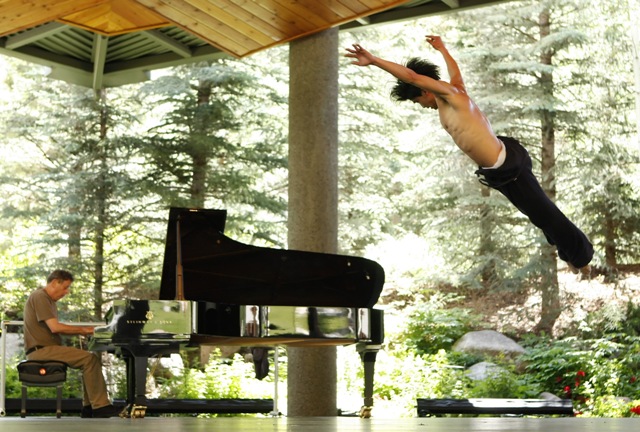CHICAGO – Patrick McDonald of HollywoodChicago.com audio review for the doc series “Charlie Hustle & the Matter of Pete Rose,” about the rise and bitter fall of the major league legend, the MLB’s all-time hits leader, only to be banned from the sport because of gambling. Streaming on MAX and on HBO since July 24th.
‘Dancing Across Borders’ Documents a Man’s Bittersweet Triumph
 Rating: 3.0/5.0 |
CHICAGO – It’s rather serendipitous that the new film “Dancing Across Borders” will have it’s Chicago premiere at the Gene Siskel Film Center, which is literally around the corner from the Oriental Theater’s production of “Billy Elliot.” The true-life story in “Borders” has some striking similarities to that of the wildly hyped musical, since they both center on a young man whose passion for dance allows him to overcome the limitations of his underprivileged upbringing.
On the surface, “Borders” seems like a straightforward vehicle for inspirational uplift. Sokvannara “Sy” Sar was a 16-year-old boy in Siem Reap, Cambodia, when he was discovered by Anne Bass, a visiting socialite and arts patron from the United States. Since age 9, Sar had always been driven to dance, despite the reservations of his parents, and found time to study at the local dance school in between chores. When Bass saw Sar perform traditional Khamer dance with his fellow school members, she was so taken by his presence and natural abilities that she offered to sponsor a trip for him to audition at New York’s School of American Ballet (SAB), where she served on the board.

Dancing Across Borders
Photo credit: First Run Features
This is where the film becomes less of a real-life “Billy Elliot,” and more of an uneasy variation on “The Blind Side,” in which a rich white lady decides to save a poor boy by assisting in the development of skills that will help him excel at the school of her choice. Now to be fair, Bass is nothing like Sandra Bullock’s bitch on wheels in “Blind,” and she does seem to genuinely care about Sar as a person instead of merely a vessel for talent. Yet the same question that nagged at me throughout “Blind” reemerged in “Borders.” Is this the life Sar truly wanted for himself, or was it imposed upon him? When he first watches footage of western ballet, Sar has no idea what to make of it, and admits his initial dislike of it. And yet, Bass’s offer certainly is hard to refuse. “Cambodian male dancers don’t have much of a future,” Bass says in an interview, while making it clear that she didn’t want Sar’s potential to go unrealized.
After a 14-minute opening sequence establishing Sar’s modest upbringing, the rest of the film follows the young fresh-faced artist during his remarkable five-year evolution into a professional ballet dancer. His initial audition at SAB failed because the instructors deemed him too old and inexperienced, thus inspiring Bass to hire renowned ballet teacher Olga Kostritsky to be his mentor. This training, combined with his eventual studies at SAB under the tutelage of dancers like Peter Boal, formed Sar into a formidable onstage presence admired by icons like Twyla Tharp and praised by the New York Times for his “unselfconscious authority.” His energy and exuberance are never in short supply, yet the rigid technicality of his movements are a far cry from the dancing he enjoyed and was aiming to master back in Cambodia.

Dancing Across Borders
Photo credit: First Run Features
Much of the footage in “Borders” was not intended to be part of a feature film at all, and was originally shot to provide Sar’s family with samples of his progress. Bass is credited as the film’s director, and she was greatly helped by editors Girish Bhargava and Mark Sutton, who structured the film into a mostly satisfying, if less than riveting, study of Sar’s remarkable transformation. There’s some terrific footage of his performances in plays such as “La Sonnambula” and “The Nutcracker,” not to mention the semifinals of the International Ballet Competition in Bulgaria, though the film could’ve benefitted from more dancing and less talking. Too much time is spent with Sar’s trainers, who mainly sing his praises while fully aware that they are partly responsible for his achievements. The voice often lacking in the film is that of Sar himself.
Though “Dancing Across Borders” is bound to inspire a great deal of aspiring dancers from all walks of life, it remains hard to tell how much of Sar’s unaffected charm and winning smile is forced for the cameras. When Sar first performs ballet for a Cambodian audience, the talking heads purport it to be a great example of bridging cultures. Yet the filmmakers could’ve performed an even greater act by truly delving into Sar’s Cambodian dancing style, while contrasting it with his work in ballet. Many of the speakers rattle off dancing terminology without bothering to explain it, thus making the majority of viewers feel as lost as Sar did during his initial training.
The most honest and poignant moment in the film comes toward the end, when Sar performs a haunting dance at the Valli International Dance Festival, with live musical accompaniment by Philip Glass. He truly seems to be channeling inner demons of loneliness and frustration on the dance floor. This footage is juxtaposed with Sar’s interview during a recent trip back to his homeland, where the smile begins to fade from his face, as he admits, “I don’t know where I belong.” Sar’s triumph is ultimately a bittersweet one, since he gained fame and acclaim while losing his sense of identity in the process. Instead of dancing across borders, he seems to be trapped between them.
 | By MATT FAGERHOLM |


